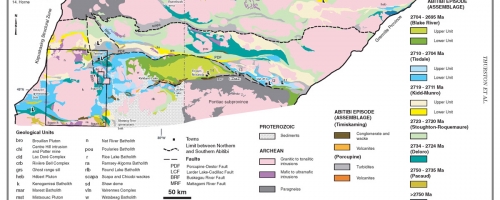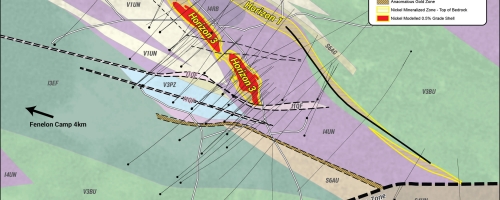Geology
Like the adjacent Fenelon Property, the Grasset Property is located within the Archean aged Harricana-Turgeon greenstone belt, part of the prolific Abitibi Sub-Province of the Canadian Shield. The Grasset Property is almost completely overburden covered with depths ranging from a few to over 80 metres. To the west, the area is dominated by a relatively high-standing sand plain, while to the east the topography falls off toward Lac Grasset. Available geological information is largely limited to historic drilling which is concentrated along the southern margin of the property and be rare isolated outcrops near Lac Grasset.
The Grasset Property was acquired by staking and covers approximately 20 kilometres of the Detour/Sunday Lake Deformation Zone ("SLDZ") and to the east covers a portion of the Lower Detour Deformation Zone as well. The SLDZ is one of four principal, east-west trending "breaks" which are the loci of over 125 million ounces of historic gold production from the Abitibi -- making it the second largest gold-bearing domain in the world. The breaks served as the principal conduits for gold-bearing fluids throughout the Abitibi. Gold deposits in the Abitibi typically exhibit high grades -- on average just under 8 g/t gold -- and tremendous vertical continuity with the Detour Gold deposit having been mined to over 800 metres vertical depth and others in the Abitibi mined to depths exceeding 2,000 metres. Thus the property is considered highly prospective for the discovery of mesothermal gold mineralization.
These two dominant structural features are separated by an area of low magnetic susceptibility interpreted to represent a sedimentary wedge developed between volcanic sequences to the north and south. The volcanic rocks north of the SLDZ have been folded around a series of granitic bodies and gneissic domes to the north, locally developing isoclinal fold structures on a regional scale which allows for the development of axial planar deformation which also has potential to host gold mineralization.
To the north of the SLDZ, the geology of the Grasset Property is dominated by mafic to felsic volcanic rocks which are, at least in the western part of the property, intruded by a northwest trending, laterally extensive series of mafic to ultramafic intrusions. These intrusive rocks – collectively the Grasset Ultramafic Complex (GUC) - are known to host nickel-PGE mineralization which is the current focus of exploration on the Grasset Property. The GUC, the area which hosts the H3 nickel sulphide discovery, forms a vertically dipping peridotite sill which has similarities to intrusions in the Mt. Keith area of Australia and certain magmatic bodies in the Raglan camp of northern Quebec.
Very limited historic drilling and geophysical interpretations suggest additional domains of felsic volcanism in the areas east and south of Lac Grasset. In a regional context this raises potential for volcanogenic massive sulphide (VMS) deposits similar to those in the nearby Mattagami camp.
Very little is known about the sedimentary domain which separates the northern volcanic sequence from a second similar sequence to the south. The sedimentary domain is 2-3 kilometres wide at the western end of the property tapering to less than a kilometre in width to the east near Lac Grasset.
The southern volcanic domain is separated from the central sedimentary domain by the Lower Detour Deformation Zone (LDDZ) which also spans some 120+ kilometres in an east-west direction from Ontario across Quebec. To the west there is locally significant gold mineralization associated with this feature but in the Grasset area it is largely untested. The southern volcanic domain is time equivalent with the rocks in the Selbaie and Mattagami VMS camps and therefore highly prospective for this style of mineralization.
Along the northern boundaries of the Grasset property the volcanic rocks are in contact with gneissic and later felsic plutonic rocks. Throughout much of the property the structural and metamorphic effects of the intrusion of this late plutonic suite are evident.


